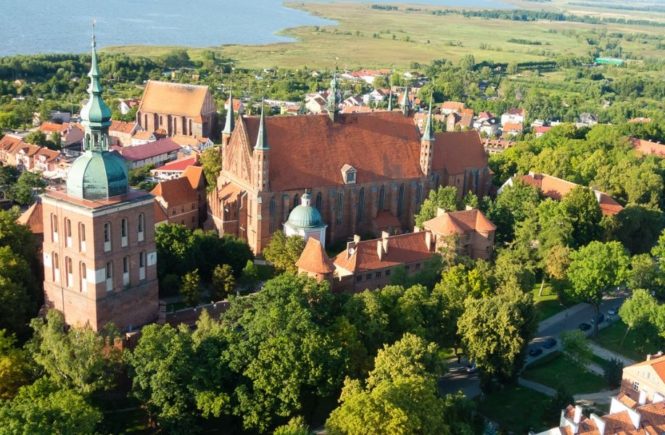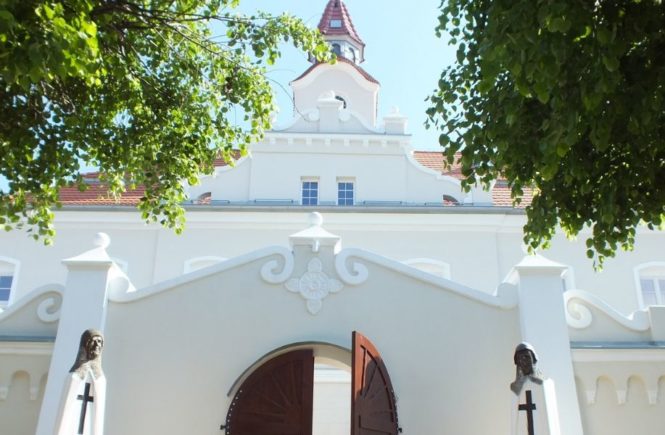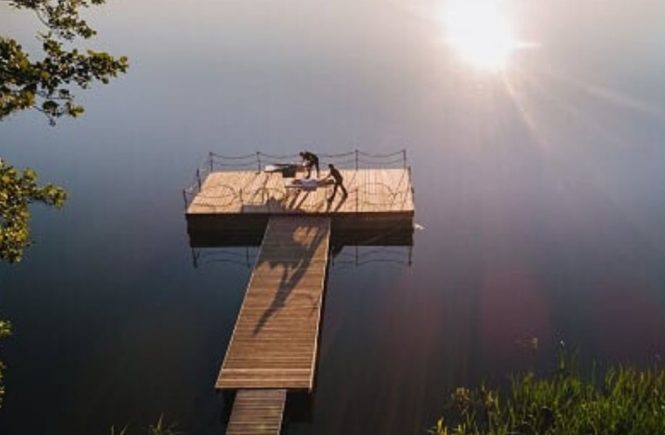Nicolaus Copernicus rearranged the world. He called the place where he discovered that the Earth goes around the sun “the end of the World”. He meant Frombork, situated on the Vistula Lagoon, a place the sky suits astronomical observations for centuries.
Frombork is one of the main towns located on the Copernicus Route. In addition, the northern stretch of St. Jacob’s Pilgrim Path [ El Camino Santiago] goes through the town. Pilgrims setting off on their journey from Estonia, Lithuania and north-east Poland usually visit the Archcathedral Basilica of the Assumption of the Blessed Mary and St. Andrew -the mother of all temples in Warmia.
Cathedral hill as well as the Canonries’ gardens are part of the beautiful panorama of the town and you are always welcomed by spectacular views, no matter from which direction you approach.
In Autumn, when the flow of tourist traffic slows down, Frombork reminds you more of a place from Copernicus’s times. It is easy to imagine the everyday work of the scientist which included observing the sky from the terrace in addition to fulfilling his duties related to being a canon in the Cathedral. There aren’t many fittings that survived from Copernicus’s times as the majority of treasures were plundered during the Polish-Swedish wars. However, up until now you can admire the altar which was the main one in the cathedral-it is called the Polyptycs of Frombork with a figure of the Apocalyptic Madonna – the patron saint of Frombork. On the Rood Beam there is a crucifix like in 1510 and in the presbytery there is a unique epitaph to canon Boreschow- a rare example of a medieval picture in the shape of a circle- a so called ‘tonda’.
In the enormous cathedral interior (90 m in length and 22 m in width) you can hear beautiful music coming from the great Frombork organs. You can easily believe that a whole orchestra is playing, not just one organ player. There are two instruments, one located in the presbytery and the other located, as traditionally found, above the main entrance to the cathedral, these open a wonderful world of sounds to your ears. The other choral organs add to the musical experience. The organ console with five keyboards is situated untypically on the floor of the cathedral. Therefore, you can admire the organ player’s skills – which involves playing two instruments at the same time in addition to that when a piece of music is played, figures of angels start to move to the music.

Gothic gables and turrets give incredible lightness to the construction of the cathedral. The cathedral is surrounded by walls, gates, towers and fortified towers. There are also residential and administrational quarters built into and part of the fortifications. Nowadays, In which once was Bishop Ferber’s Palace there is the Museum of Nicolaus Copernicus (Muzeum Mikołaja Kopernika).

Near the cathedral there is a Chapterhouse-a place where Chapter meetings have been held for ages. During times of danger the canons living outside the walls found shelter in different curia inside the cathedral fortifications. Nicolaus Copernicus found shelter in a tower in the north-west part of the walls. The tower is still preserved today. The other Tower, known as Radziejowski’s Tower, functioned as a belfry. Nowadays, on the ground floor of the belfry there is a Planetarium. The Tower is regarded as a great viewing point and from a height of 70 m above sea level you can take in the striking panoramas of the town’s surroundings, the Vistula Lagoon and even the Vistula Spit. During the summer, it’s easy to sail to Krynica Morska from Frombork. The shortest way from Warmia to the other side of the lagoon and the sandy seaside beaches on the Vistula Spit is by ship or ferry.

The cathedral crypts are the place where the remains of Warmian bishops and canons are in eternal rest. Among them, there are the remains of Nicolaus Copernicus which were only identified a few years ago. Copernicus was laid to rest in accordance with standard practices of burial and he was buried close to the altar he took care of. Now, travellers from all over the world stop at the grave of the great astronomer in order to pay tribute to the man whose ideas were revolutionary and long ahead of his times. Nicolaus Copernicus was a respected medical doctor, an expert in canon law and an administrator of the estates of the Chapter. The publication of Copernicus’s book De Revolutionibus Orbium Coelestium took place just before his death in 1543. Surely, the book wouldn’t have been published in print if it hadn’t been for Jerzy Joachim Retyk’s persistence. Retyk was a young mathematician from the University of Wittenberg who came to Frombork to learn Copernicus’ achievements.
Besides the most famous works of art and attractions, you should also visit and see places which are less well known. You can see the canonries outside the fortified walls –they are just located outside as you leave through the main gate. In the place of the present location of St.Stanislaw’s Canonry there was the house of Nicolaus Copernicus. In the XVI and XVII centuries, the house was expanded but the cellars can recall the times of the most famous of all Frombork canons. While going down the Cathedral hill, a short walk to the east, you will reach ul.Stara where the Hospital of the Holy Spirit is located, dating back to the XV century, there’s the Museum of Medicine with a Herb Garden. The Herb Garden lets visitors see and learn the names of plants which grow in the Polish countryside as well as plants found in Mediterranean areas. In the museum you can also visit the exhibition entitled ‘Profesjonalne zabawy z ciałem’ (Professional fun with the human body). The museum refers to Nicolaus Copernicus’s passion in medicine. After finishing medical studies, for which Copernicus was given a holiday, he treated the most renowned people from his surroundings – like the bishops and canons of Warmia.
In the southern part of the town, the Water Tower(Wieża Wodna) is worth visiting. The oldest Tower of a rare type in Poland. It was used for providing the cathedral and other buildings on the hill with fresh water in the XVI century. Nowadays, near the Water Tower you can drink a coffee or buy postcards showing pre-war Frombork. Unfortunately, there aren’t many buildings existing from that time as that part of the town was badly damaged in World War 2.
Frombork is a picturesque, neat and cosy place in Warmia that takes care of its development. The town is always striving to be more and more beautiful. Copernicus’s Canal (Kanał Kopernika) has been recently been renovated and given a facelift. The town square as well as the monument at ul. Błotna have been revitalised. The Cathedral Complex in Frombork became an official National Historic Monument and was awarded first place in the Cultural Attractions of Warmia and Masuria.

Frombork, located on ‘Copernicus’s edge of the World’ and still waiting to be discovered by locals, pilgrims and tourists alike.







